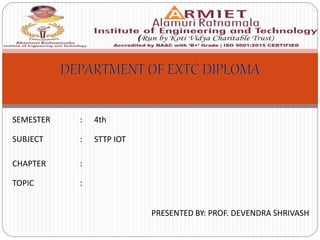
IOT DEVENDRA SHRIVASH.pptx
- 1. SEMESTER : 4th SUBJECT : STTP IOT CHAPTER : TOPIC : PRESENTED BY: PROF. DEVENDRA SHRIVASH
- 2. IoT ?
- 3. The Internet of Things (IoT) refers to the ever-growing network of physical objects that feature an IP address for internet connectivity, and the communication that occurs between these objects and other Internet-enabled devices and systems. In simple words, Internet of Things (IoT) is an ecosystem of connected physical objects that are accessible through the internet. It is also referred to as Machine-to-Machine (M2M), Skynet or Internet of Everything.
- 4. Components of IoT Smart Systems and Internet of Things are driven by a combination of : 1) Sensors 2) Connectivity 3) People & Processes
- 5. Why IoT ? Dynamic control of industry and daily life. Improves the resource utilization ratio. Integrating human society and physical systems. Flexible configuration. Acts as technology integrator. Universal inter-networking.
- 6. What is the scope of IoT ? Internet of Things can connect devices embedded in various systems to the internet. When devices/objects can represent themselves digitally, they can be controlled from anywhere. The connectivity then helps us capture more data from more places, ensuring more ways of increasing efficiency.
- 7. Corporate aspect IoT is a transformational force that can help companies improve performance through IoT analytics and IoT Security to deliver better results. Businesses in the utilities, oil & gas, insurance, manufacturing, transportation, infrastructure and retail sectors can reap the benefits of IoT by making more informed decisions, aided by the torrent of interactional and transactional data at their disposal.
- 8. How can IoT help ? IoT platforms can help organizations reduce cost through improved process efficiency, asset utilization and productivity. The growth and convergence of data, processes and things on the internet would make such connections more relevant and important, creating more opportunities for people, businesses and industries.
- 9. Current status & future prospect of IoT By the year 2020, there will be a lot more connected devices than people on earth
- 10. A Gateway to the future!
- 11. Progress Index The sky’s not the limit. It’s only the beginning with IoT!
- 14. You name it, and you will have it in IoT!
- 15. How much more IoT can do is only left to you imagination!
- 16. Challenges faced by IoT At present IoT is faced with many challenges, like - Scalability Security Technical requirements Technological standardization Software complexity
- 17. Solutions to the challenges Several solutions are proposed to overcome the problems. Some of them are - Overcoming compatibility issues is a significant IoT hurdle, but emerging companies are starting to enable increased interoperability through open-source development. Governments and industry bodies need to set standards and regulations for the various industries to ensure that data is not misused. IoT needs strong authentication methods, encrypted data and a platform that can track irregularities on a network.
- 18. Conclusion Projections for the impact of IoT on the Internet and economy are impressive, with some anticipating as many as 100 billion connected IoT devices and a global economic impact of more than $11 trillion by 2025. The potential economic impact of IoT is huge, but the journey to IoT adoption is not a seamless one. There are many challenges that face companies looking to implement IoT solutions. However, the risks and disadvantages associated with IoT can be overcome.
